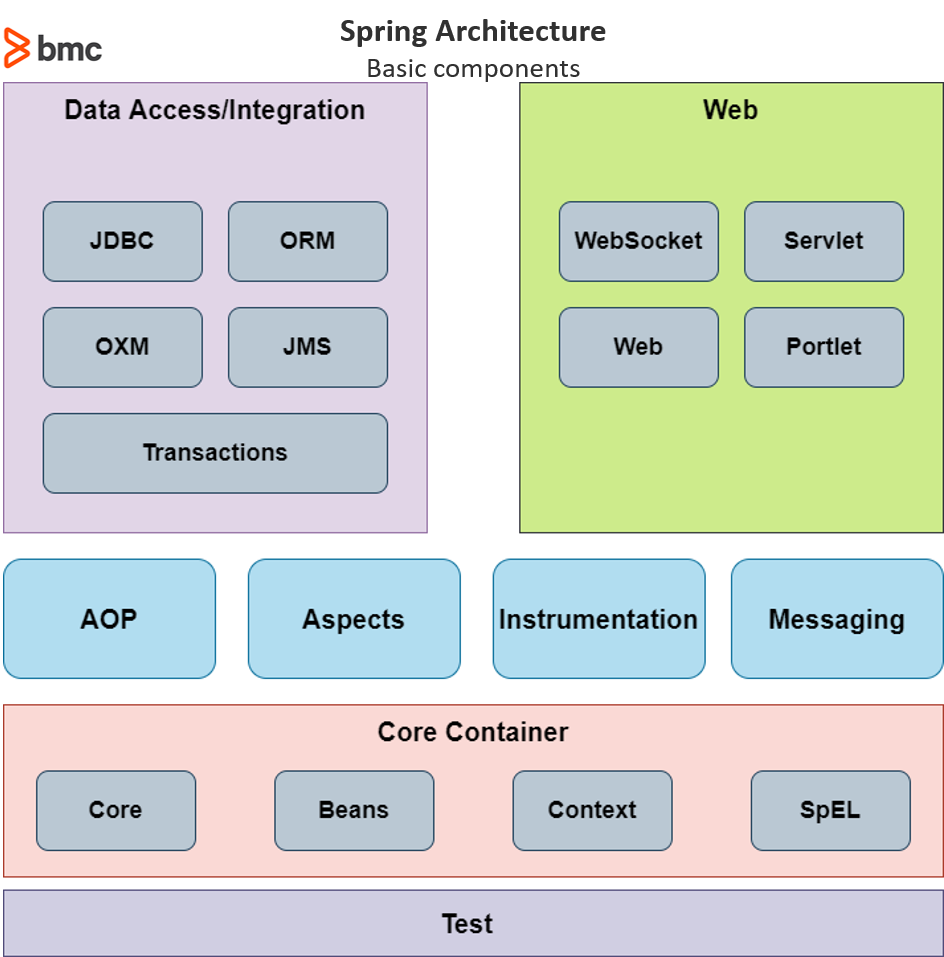On this page
it is an open source framework for building enterprise Java apps
it aims to simplify the complex and cumbersome enterprise Java app development process by offering a framework that includes technologies such as
Aspect-oriented programming (AOP)Dependency Injection (DI)Plain Old Java Object (POJO)
it is a lightweight framework that can be used to create scalable, secure, and robust enterprise web apps
it can be considered as a collection of sub frameworks such as
Spring Web Flow Spring MVC Spring ORM
Spring also supports Kotlin and Groovyit is also the base that powers all other spring based projects such as
Spring Boot Spring Cloud Spring GraphQL
Core Features
Inversion of Control (IoC) Container
it is one of the core features of Spring that provides a streamlined way to configure and manage Java objects
it is responsible for managing the lifecycle of a defined Java object, significantly increasing the configurability of a Spring-based application
it uses the dependency injection or dependency lookup patterns to provide the object reference during runtime
it consists of assembler code that is required for configuration management
Spring provides org.springframework.beans and org.springframework.context packages that can be used to facilitate these functions
Support for aspect oriented programming
AOP aims to provide more modularity to the cross-cutting concerns, which are functions that span across the application, such as
Logging
Caching
Transaction management
Authentication
AOP complements object-oriented programming by providing a different way to structure the program, where OOP modularity is based on classes
In AOP, the main unit of modularity is an aspect (cross-cutting concern)
This enables users to use AOP to create custom aspects and declarative enterprise services
The IoC container does not depend on AOP, offering further freedom for developers to select their preferred programming method
However, Aspect-Oriented Programming combined with the Spring IoC provides a robust middleware solution
Data access framework
Database communication issues are one of the common issues developers face when developing applications
Spring simplifies the database communication process by providing direct support for popular data access frameworks in Java, such as
JDBC, Hibernate, Java Persistence API (JPA)
it offers features such as resource management, exception handling, and resource wrapping for all the supported data access frameworks, further simplifying the development process
Transaction management framework
Unlike the Java Transaction API (JTA), the Spring Transaction Management Framework is not limited to global and nested transactions
Spring offers an abstraction mechanism for Java that enables users to:
Work with local, global, and nested transactions
Save points
Simplify transaction management across the application
The Spring Data Access Framework directly integrates with the Transaction Management Framework with support for messaging and caching
This enables developers to create feature-rich transactional systems that span across the applications without depending on EJB or JTA
Spring MVC framework
The Spring MVC enables developers to create applications using the popular MVC pattern
It is a request-based framework that allows developers to easily create customized MVC implementations that exactly suit their needs
The core component of Spring MVC is the DispatcherServlet class which handles user requests and then forwards them to the correct controller
This allows the controller to process the request, create the model and then provide the information to the end-user via a specified view
Spring web service
This Spring Web Service component provides a streamlined way to create and manage web service endpoints in the application
It offers a layered approach that can be managed using XML and can be used to provide mapping for web requests to a specific object
Spring test frameworks
Spring simplifies testing within the framework with components like
Mock objects
TestContext framework
Spring MVC Test
Spring Framework Architecture
Spring is built using different modules that enable different functionality
Core container
This contains the fundamental modules that are the cornerstone of the Spring framework
Core (spring-core) is the core of the framework that power features such as Inversion of Control and dependency injectionBeans (spring-beans) provides Beanfactory, which is a sophisticated implementation of the factory patternContext (spring-context) builds on Core and Beans and provides a medium to access defined objects
ApplicationContext interface is the core part of the Context module, and the spring-context-support provides support for third-party interactions such as caching, mailing, and template engines
SpEL (spring-expression) enables users to use the Spring Expression Language to query and manipulate the object graph at runtime
Data access/integration
This includes the modules that are used to handle data access and transaction processing in an application
JDBC (spring-jdbc) provides a JDBC abstraction layer that eliminates the need to separate JDBC coding when dealing with databasesORM (spring-orm) are integration layers for popular object-relational mapping API such as JPA, JDO HibernateOXM (spring-oxm) is the abstraction layer that supports Object/XML mapping implementations like JAXB, XStreamJMS (spring-jms) is the Java Messaging Service module that creates and consumes messages that directly integrate with the Spring messaging moduleTransaction (spring-tx) offers programmatic and declarative transaction management for classes that include special interfaces and POJOs
Web
The Web layer relates to modules that power web-based functions in Spring
WebSocket (spring-websocket) powers the web socket-based communication for clients and serversServlet (spring-webmvc) is the Spring WebMVC module that contains the MVC and REST implementationsWeb (spring-web) provides all the basic web-oriented features and contains an HTTP client and web-related parts of the Spring remotingPortlet (spring-webmvc-portlet) provides the MVC implementation to be used in a portlet environment
Other Modules
AOP (spring-aop) provides an aspect-oriented programming implementation that can be used when creating applicationsAspects (spring-aspects) enables direct integration with the AspectJ programming extension by the eclipse foundationInstrumentation (spring-instrument) is the class instrumentation support and class loader implementations for application serversMessaging (spring-messaging) provides a robust platform to manage messaging in applicationsTest (spring-test) is the Spring test module that supports unit and integration testing with JUnit and TestNG 